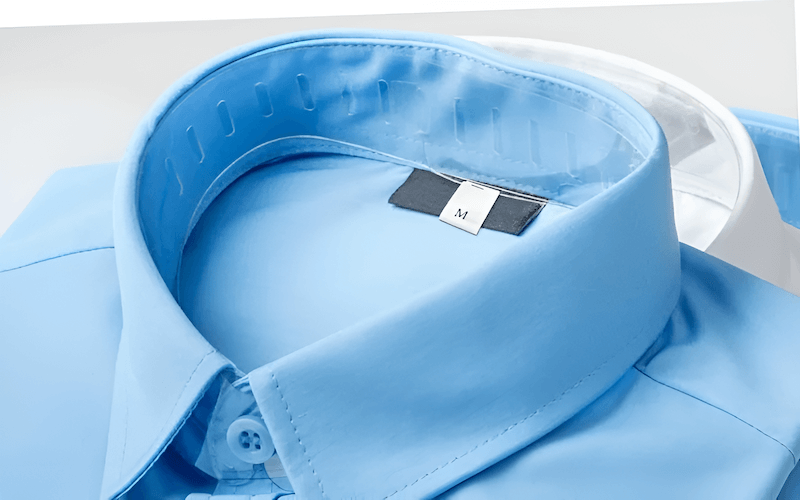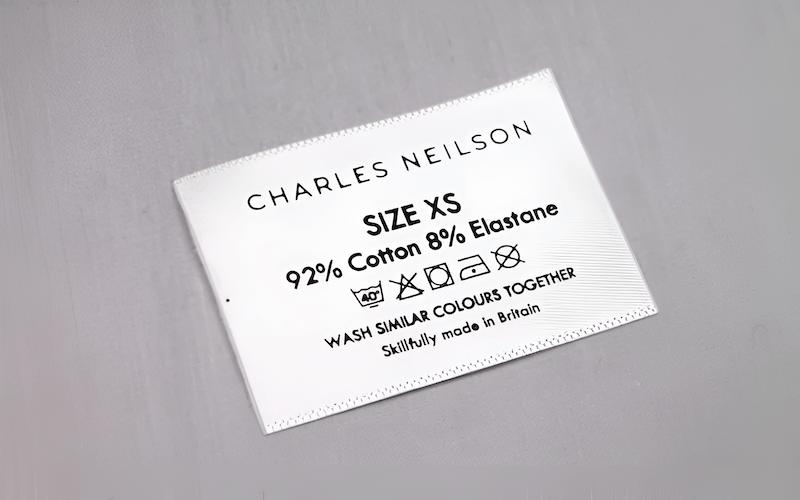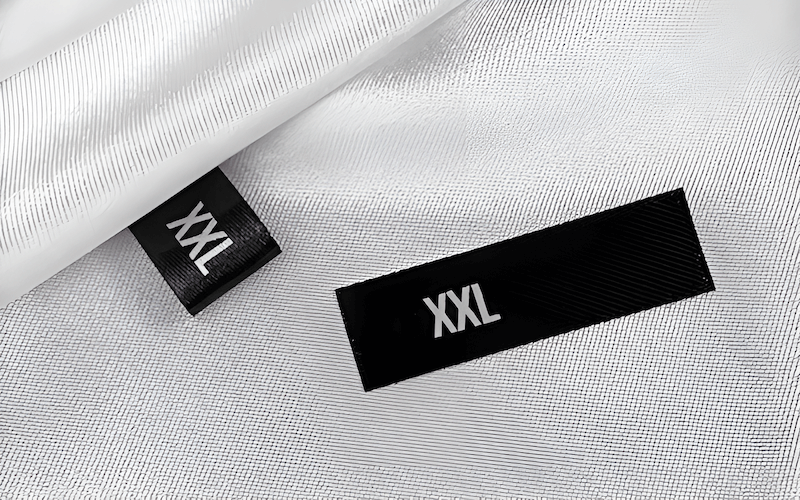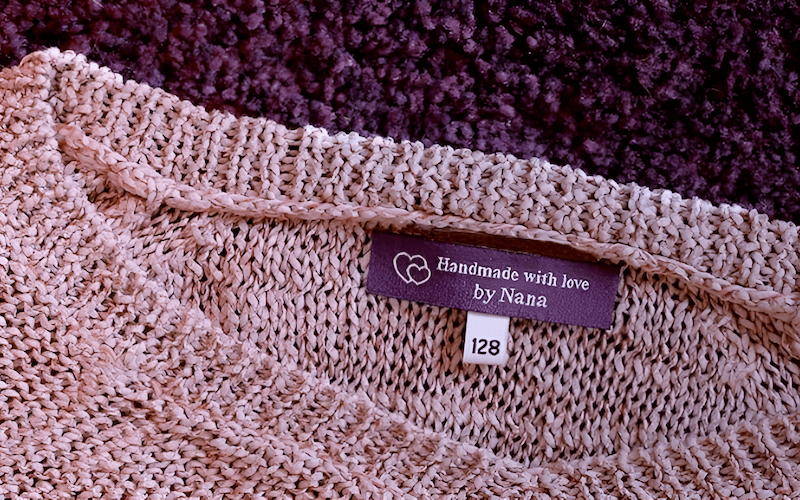Clothing Size Labels: Woven, Printed and Custom for Brands
When launching or managing a clothing brand, especially for small businesses venturing into wholesale and retail, seemingly minor details can have a significant impact. One such detail is the material of your clothing size labels.
Selecting the best material for size labels is more than just a functional necessity; it contributes to the overall quality, durability, and even the perceived value of your apparel and garments. This guide provides valuable insights to help businesses make an informed decision that benefits both customer satisfaction and brand image.
1. Why size label material matters
Choosing the right material for clothing size labels often gets overlooked, but it’s a surprisingly important decision. It’s not merely about indicating the size; the material impacts several key aspects of the garment and the customer’s experience. Key factors and considerations come into play that can influence the longevity of the clothing, customer comfort, brand perception, and even legal compliance.
1.1 Durability and washability: Will it last?
A crucial factor is how well the size label holds up over time, particularly through repeated washing and wear and tear. Think about a favorite shirt that’s been through countless laundry cycles. If the size label fades, frays, or detaches, it diminishes the garment’s usability and can be frustrating for the customer. Durability and washability are directly linked to the materials used.
Some materials can withstand high washing temperatures and harsh detergents, while others might degrade quickly. Choosing a material that can endure the typical lifespan of the garment, maintaining its legibility and integrity, is essential for maintaining customer satisfaction and reflecting the quality of your product. Consider how a consumer would feel if the label of their new item vanished after the first wash.
1.2 Comfort and feel: The skin-contact factor
Comfort is paramount, especially for garments worn close to the skin, like underwear, baby clothes, or activewear. The texture and softness of the size label material become incredibly important because of this skin contact. A rough or scratchy label can cause irritation and discomfort, potentially deterring customers from purchasing or wearing the item. Selecting hypoallergenic materials with good breathability is also vital for sensitive skin. Prioritizing a material that feels pleasant against the skin ensures a positive wearing experience.

1.3 Cost-effectiveness: Balancing budget and quality
For businesses, especially those just starting, budget considerations are always a primary concern. However, it’s crucial to find the right balance between cost and quality when choosing size label materials. Opting for the cheapest option might seem appealing initially, but it could lead to higher replacement costs in the long run if the labels don’t hold up. Consider the long-term value: a slightly more expensive, but more durable, material might save money by reducing the need for frequent replacements or dealing with customer complaints about damaged labels. Exploring options like bulk discounts can also help manage expenses while still ensuring quality. It’s about finding the most affordable solution without sacrificing the essential qualities of a good size label.
1.4 Brand presentation and aesthetics
Size labels, although small, contribute to the overall presentation of the garment and the brand image. The label’s aesthetics, including the font, color, and printing quality, should align with the brand’s identity. A high-quality, well-designed label can subtly enhance the perceived value of the clothing, conveying a sense of professionalism and attention to detail. A luxurious garment, for example, benefits from a label with a premium feel, while a casual, everyday item might suit a more simple, yet still well-made, label.
1.5 Compliance and regulations
Navigating the world of apparel manufacturing involves adhering to various legal and regulatory requirements, and size labels are no exception. Different countries and regions have specific standards regarding the information that must be included on clothing labels, and sometimes even the materials that can be used. Businesses must ensure their size labels meet these consumer regulations to avoid potential legal consequences, such as fines or product recalls. Staying informed about these requirements is essential for responsible and compliant operations.
2. Common size label materials: A detailed comparison
Choosing the right material involves understanding the properties, pros, and cons of each option. This section provides a comprehensive overview of the most commonly used size label materials, helping businesses make an informed choice based on their specific needs. The following table and detailed descriptions will offer a comparative analysis.
| Material | Durability | Washability | Comfort | Cost | Sustainability | Best For |
|---|---|---|---|---|---|---|
| Polyester | High | High | Good | Low-Medium | Can be Recycled | General apparel, activewear |
| Cotton | Medium | Medium | Excellent | Medium | High (Organic Option) | Baby clothes, delicate items, natural brands |
| Satin Polyester | Medium-High | High | Excellent | Medium-High | Can be Recycled | Lingerie, formal wear, premium items |
| Tyvek | Very High | High | Fair | Medium | Can be Recycled | Outerwear, industrial garments |
| Recycled Materials | Varies | Varies | Varies | Varies | High | Eco-conscious brands |
2.1 Polyester: The workhorse
Polyester is a popular choice for size labels due to its inherent durability and versatility. This synthetic material is known for being washable, wrinkle-resistant, and colorfast, meaning it can withstand repeated laundering without significant fading or degradation. It’s also generally fray-resistant, thanks to the ability to heat-seal the edges. This makes it a reliable option for a wide range of garments, from everyday wear to activewear. Polyester is also relatively cost-effective, making it an accessible choice for businesses of all sizes.
- Pros: Durable, washable, wrinkle-resistant, colorfast, fray-resistant, cost-effective.
- Cons: Not as soft as cotton, can feel synthetic.
- Best For: General apparel, activewear, items requiring frequent washing.
2.2 Cotton: The natural choice
Cotton is a natural fiber renowned for its softness and breathability, making it a comfortable option for size labels, especially for garments worn close to the skin. It’s also absorbent and hypoallergenic, making it a good choice for people with sensitive skin or for baby clothes. Organic cotton options further enhance its appeal for environmentally conscious brands.
- Pros: Natural, soft, breathable, comfortable, absorbent, hypoallergenic, organic options available.
- Cons: Less durable than polyester, prone to wrinkling, may shrink, colors may fade slightly over time.
- Best For: Baby clothes, delicate items, underwear, natural or organic clothing brands.
2.3 Satin polyester: The luxurious touch
Satin polyester offers a smooth, shiny, and soft texture that adds a touch of elegance and luxury to garments. This material has a beautiful drape and a premium feel, making it a popular choice for lingerie, formal wear, or high-end clothing items. Like regular polyester, it’s also durable and washable, but its main draw is its aesthetic appeal.
- Pros: Smooth, shiny, soft, drapes well, luxurious feel, durable, washable.
- Cons: Can be more expensive than regular polyester, may snag if not handled carefully.
- Best For: Lingerie, formal wear, evening gowns, premium clothing items, accessories.

2.4 Tyvek: The ultra-durable option
Tyvek is a unique, synthetic material known for its exceptional strength and durability. It’s tear-resistant, water-repellent, and chemical-resistant, making it suitable for garments that need to withstand harsh conditions. While it has a paper-like texture, it’s far more robust than paper. Tyvek is often used for outerwear, industrial garments, or protective clothing.
- Pros: Tear-resistant, water-repellent, chemical-resistant, lightweight, durable.
- Cons: Not as soft or comfortable as other options, can be stiff, limited aesthetic appeal.
- Best For: Outerwear, industrial garments, protective clothing, workwear, items requiring extreme durability.
2.5 Recycled materials: The sustainable path
In today’s increasingly eco-conscious market, recycled materials are gaining popularity for all aspects of garment production, including size labels. These materials, such as recycled polyester or options like Newlife™ yarn (made from recycled plastic bottles), offer a way to reduce environmental impact and appeal to sustainable-minded consumers. Many recycled materials are also certified by organizations like OEKO-TEX, ensuring they meet certain environmental and safety standards.
- Pros: Environmentally friendly, reduces waste, appeals to eco-conscious consumers, can be durable and versatile.
- Cons: May be slightly more expensive than non-recycled options, availability may vary.
- Best For: Eco-conscious brands, sustainable clothing lines, companies with a commitment to environmental responsibility.
3. Choosing the right material for your needs
Selecting the ideal size label material requires careful consideration of several factors, including the specific garment type, budget constraints, sustainability goals, and the intended application method. This section provides guidance and recommendations to help businesses make informed decisions that align with their unique requirements.
3.1 Considering your garment type
The type of clothing being labeled is a primary factor in choosing the appropriate material. For example, delicate fabrics like silk or lace would benefit from a soft, lightweight label like cotton or satin polyester to avoid damage or discomfort.
Baby clothes require extra attention to softness and hypoallergenic properties, making cotton a natural choice. Activewear, on the other hand, needs durable and washable labels that can withstand sweat and frequent laundering, making polyester a suitable option. Outerwear might require the extreme durability of Tyvek. Thinking about the specific needs of each clothing category helps narrow down the best material choices.

3.2 Factoring in your budget
Budget constraints are a reality for most businesses, and it’s essential to find a balance between cost and quality. While polyester is generally the most affordable option, it’s crucial to consider the long-term cost. Investing in slightly more durable materials might save money in the long run by reducing the need for replacements. Analyzing the value for money, rather than just the upfront price, is a key aspect of making a sound financial decision.
3.3 Thinking about sustainability
Environmental responsibility is becoming increasingly important to consumers, and businesses are responding by incorporating sustainable practices throughout their operations. Choosing eco-friendly size label materials, such as those made from recycled content or organic cotton, is a way to demonstrate a commitment to sustainability.
This can enhance brand image and appeal to environmentally conscious customers. Exploring options like recycled polyester or Newlife™ yarn can significantly reduce the environmental impact of label production.
3.4 Label application method
The way a label will be attached to the garment that will be crucial to the long-term endurance.
- Sew-on labels: Known for their durability and versatility, sew-on labels are a classic choice. However, they require sewing skills or equipment for proper attachment.
- Iron-on Labels: These labels offer ease of application, making them convenient for quick projects. They are suitable for certain fabrics that can withstand heat, but they may not be as durable as sew-on options, especially with frequent washing.
- Heat Transfer Labels: This method provides a smooth finish that feels integrated with the fabric. Heat transfer is good for detailed designs and logos, but it requires heat press equipment for application.

4. Related questions
This section addresses some common questions related to size label materials, providing concise and informative answers.
4.1 Can I use different materials for different sizes?
While technically possible, it’s generally recommended to maintain consistency in material across all sizes for a cohesive brand presentation.
4.2 Are there any regulations about label size itself?
While regulations primarily focus on content, there aren’t usually strict rules about the physical dimensions of the label, offering design flexibility.
4.3 How do I ensure my labels are colorfast?
Choosing materials known for colorfastness, like polyester, and using high-quality printing methods are key to preventing fading.
4.4 Where can I source eco-friendly label materials?
Many label suppliers now offer recycled and sustainable options. Research suppliers who specialize in eco-friendly materials.
Read more:
Choosing the best size label material is a multifaceted decision that involves balancing durability, comfort, cost, aesthetics, and sustainability. By carefully considering the factors outlined in this guide – garment type, budget, environmental impact, and application method – businesses can select the material that best meets their needs and contributes to a positive customer experience. The right choice enhances the overall quality and perceived value of the garment, ultimately reflecting positively on the brand.






















